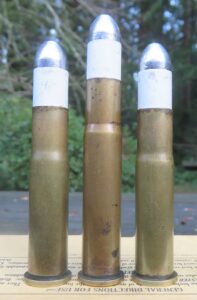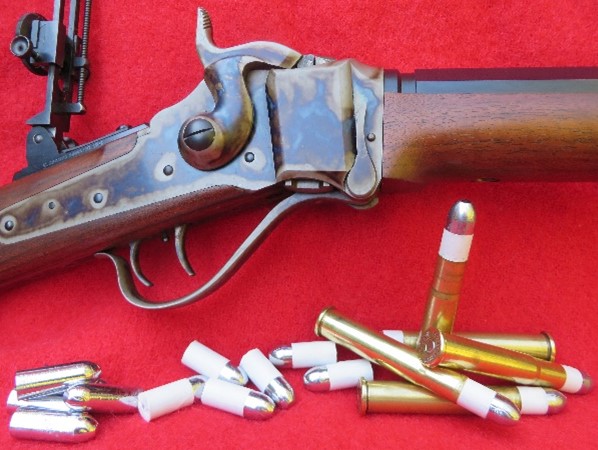
By Mike Nesbitt | Contributing Editor
Another look at paper patching is on my mind for this visit because I had been wanting to try a bullet mold with a different diameter for my .44-77 Sharps and while thinking about getting that new mold, I followed my own advice.
That worked out really well; so well that I can’t help but brag about it.
Here’s how it all came about. I’ve been shooting my rifles in .44-77 caliber for several years and that is one of my very favorite Sharps calibers. My best bullet mold for a paper patched bullet is from KAL in Canada and it drops a tapered cup-based bullet with a diameter at the base of .432” which was considered a very good choice for the .44 Sharps. While using that bullet, loaded to duplicate the old Sharps loadings with a 405-grain bullet over 75 grains of powder, I had made some good shots. But those good shots were mostly individuals which didn’t lead me to getting good groups or to boastful scores in competition. So, paper patched bullet shooting in my heavy .44-77, the fine rifle I call “Hefty Hannah,” was put on the back burner for a while.
I was able to dis-assemble an old factory load for the .44-77 by UMC that had a 405-grain paper patched bullet. That bullet was measured and near the base it had a diameter of .438-inch which immediately put me on the trail of a bullet mold for the .438-inch slugs. But, as I have recommended, it’s better to try some first.
I looked to see if Buffalo Arms Company offered bullets for paper patching in that size. They do! Just before ordering some, I checked to see if I already had some. I did! Ten of those bullets were quickly patched and at the range they showed an improvement over the .432-inch bullets.
So, another 100 of the .438-inch diameter bullets each weighing 400 grains, were ordered from Buffalo Arms. But those are being saved for shooting yet to come.
Following that, I remembered that I had a mold made by Accurate Molds to cast 450-grain paper patched bullets for my good old .44-90 Sharps. Bullets from that mold hadn’t been used in quite a while. They are tapered bullets, with a diameter just behind the nose of .430” then tapering back to a full .438” at the base. There was the bullet I needed to give a good try.
My .44-90 is a rifle I have mentioned far too little and I must credit it with many things. It is the rifle that has given me my best wins and my best long-range shooting, including good hits on a buffalo target at 1200 yards, down with the Great Basin Sharpshooters near Bend, Oregon. My best scores in one of our Old West Centerfires matches were made with this .44-90, using grease groove bullets, and those scores were a 94 at 100 yards followed by another 94 at 200 yards. That made me the winner of the match back in 2017 when my eyes must have been younger. This gun also gave me my highest score at Quigley and Wes Daems, the 2015 winner at Quigley, said I had the loudest rifle on the firing line. Why I quit using the .44-90 I really can’t say except that after Hefty Hannah was built, I gave the new rifle in .44-77 most of my attention.
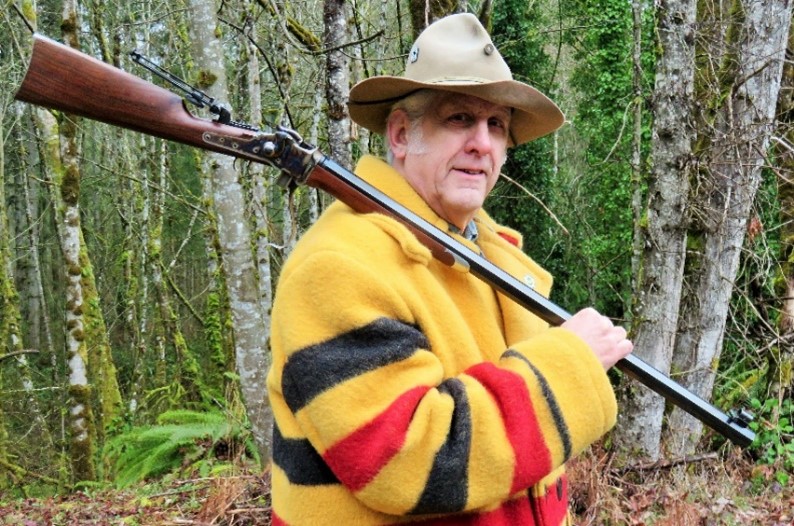
It was certainly time to try the .44-90, with its 32-inch barrel, again. First, a batch of the 450-grain bullets from the Accurate mold were cast, and then patched with two wraps of the nine-pound paper from Buffalo Arms. Ten of those were loaded in .44-77 cases, over 70 grains of Swiss 1½ Fg powder while another ten were loaded in the 2 5/8-inch cases for the .44-90, over 90 grains of the Swiss 1½ Fg powder.
On my next trip to the range, a target for each rifle was posted at 100 yards and all ten of the loads for the .44-90 were fired with poor results, while only five of the loads for the .44-77 were tried. The .44-77 performed the best between those two but there’s a lot more to say about the shooting.
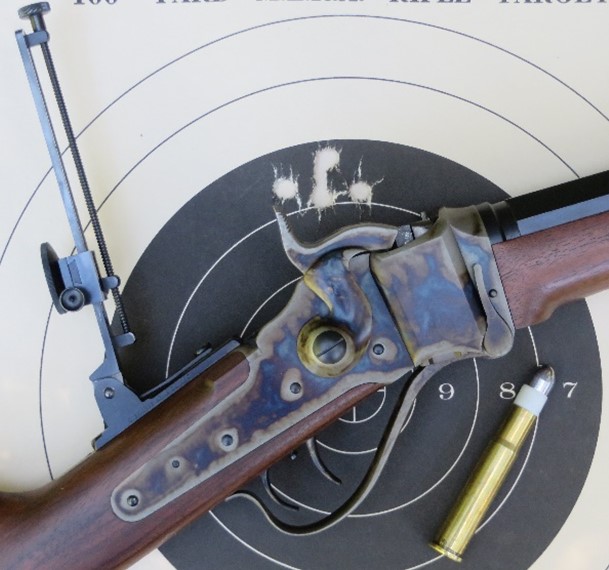
I need to load more with those 450-grain bullets for both rifles. For one thing, the bullets were seated just a little too far forward. They would chamber just fine in a clean barrel but after each shot, the barrel had to be wiped in order to accept the next cartridge. While target shooting, wiping the bore between shots with black powder cartridge rifles is often a standard practice but with my .44-90 I often needed to force the cartridge into the chamber with a chambering cam. That can really mean my paper patched bullets were not entering the chamber consistently.
More than a few years ago I was using this same bullet in the very same .44-90 (I’ve only had one rifle in that caliber) with good results. Those loads used 90 grains of GOEX’s Olde Eynsford 1½ F powder along with an .060-inch Walters’ wad along with a 1/8-inch of lube plus another wad under the bullet that was punched from a milk carton. When those cartridges were chambered, I could just barely feel the bullets entering the rifling, just beginning to touch the lands in the barrel.
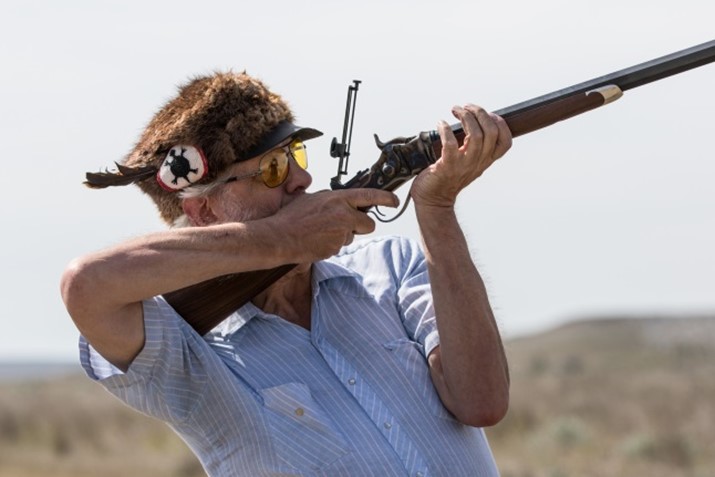
Five rounds were fired, with the first shot taking advantage of the clean barrel. That shot hit the target very close to the X, which certainly pleased me. The next four shots also pleased me but they went higher, all into the 7-ring on the 100-yard target but grouping nicely. With those shots no wiping was done and only a blow-tube was used to soften the fouling. In the photo of this target, the rifle is covering the hit near the X and only the 4-shot group is shown.
That four-shot group is what I’m going to duplicate with more shooting and I’ll just need to do a little tweaking to get it. Once that happens, a possible “victory story” will be put together. We already know the .44-90 is up to it, now let’s see if I am…
The 450-grain bullets were seated too far forward for the .44-77 too but not quite as badly. Those loads chambered much easier and the target shows at least a slight advantage. My group with three shots hitting nicely in the black with two shots going to the left is not the best but at least this is something to work on. In black powder cartridge shooting we don’t always get our favorite targets on the first try. So, more paper patched bullets will be loaded again, with some tweaking of the load which might be in the selection of powder, the wads beneath the bullet, the amount of lube beneath the bullet, the alloy of the bullet, and the changing seating depth will be tried. As always, when tweaking a load, it is best to make just one change at a time so the effects of that change can be recognized.

While the group shown from the shooting with the .44-77 is not the best, it is still a positive thing because, those shots did not go wild. I’m sure better groups can be shown next time.
There will certainly be a ‘next time’ too, even though I’ll have some other shooting to do which is in my way, so to speak, before getting back to making more paper patched loads. But I’ll soon be back with my shooting of the paper patched bullets and that will include both the .44-77 and the .44-90, maybe even the .44-70 which I don’t shoot enough. Of course, to complicate things just a little more, let’s include the .50-70 because the annual paper patch match of the Black River Buffalo Runners is coming soon

